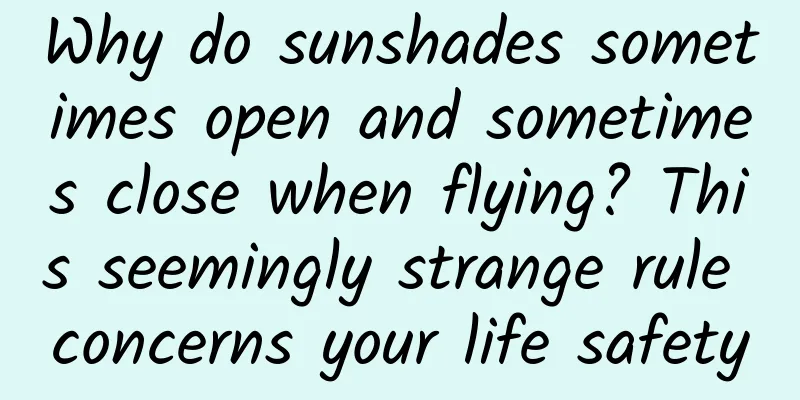Why do sunshades sometimes open and sometimes close when flying? This seemingly strange rule concerns your life safety

|
When flying on an airplane, many passengers prefer window seats, which not only allow them to look out the window at the receding city and the endless sea of clouds, but also allow them to close the sunshade conveniently, fall asleep peacefully, and enjoy the long tranquility. Why do flight attendants repeatedly remind passengers to open the sunshade every time the plane takes off or lands? British comedian Jack Whitehall once asked a flight attendant this question that most passengers have in mind. "Sir, if the plane engine fails, you are responsible for observing for the pilot." After hearing this answer, he suddenly realized that even a small sunshade is closely related to the safety of passengers' lives. Sunshades are equivalent to curtains in the cabin. Generally, the shape of aircraft windows is oval or rectangular (rectangle with curved corners), and sunshades are panels that are embedded in the aircraft shell and can be pushed and pulled to block the window. Since aircraft are usually above the clouds when flying at high altitudes and are exposed to stronger sunlight, sunshades can block the sunlight for passengers to protect their eyesight, and can also play a role in sound insulation and heat insulation during the flight, providing passengers with a more comfortable flying environment. Under normal circumstances, opening the sunshade during takeoff and landing can illuminate the cabin environment and reduce energy supply. Takeoff and landing are critical stages in the flight. In order to ensure the energy supply of the aircraft, the cabin lights need to be dimmed so that the energy generated by the engine is mainly used to provide power. At this time, open the sunshade to let light into the cabin, and the cabin will not be too dark. At the same time, opening the sunshade can balance the light and darkness inside and outside the cabin, which helps the occupants to adapt to the changes in external light in advance and reduce discomfort when getting off the plane. In the event of an emergency that causes an aircraft failure, opening the sunshade can increase the lighting area, prevent passengers in the dim cabin from crowding and trampling because they cannot see the surrounding conditions clearly, and improve evacuation efficiency. This also explains why the aircraft not only has to open the sunshade but also turn off the lights when taking off and landing at night, because it is to allow the passengers to adapt to the dark environment outside in advance. If an emergency occurs, the cabin may suddenly lose power, and the sudden darkness will temporarily affect the vision of the passengers, posing a hidden danger to evacuation. The reason for opening the sunshade during takeoff and landing is to make it easier for passengers to observe the environment outside the aircraft and to allow crew members to respond to emergencies in a timely manner. During takeoff and landing, the fuselage is subjected to greater pressure and vibration, and the strength of the portholes is relatively weak. If the portholes are covered, passengers cannot see the external situation, which may cause negative emotions such as fear and doubt, and even cause unnecessary panic. If it rains or snows, passengers can understand the weather conditions through the portholes, prepare themselves mentally in advance, and maintain a sense of direction. If an emergency occurs, such as engine failure or landing device failure, the crew needs to keep abreast of the external situation, assess the risks, and make correct decisions. In addition, opening the sunshade can also help passengers choose an escape route in the event of an accident. If an explosion or fire occurs during takeoff or landing, passengers can observe the situation through the portholes, avoid the direction of the fire and smoke, and evacuate the cabin more safely and quickly. For rescuers, they can also observe the situation in the accident cabin through the portholes, make accurate judgments in time, and implement effective rescue, thereby saving more lives. In 2017, a United Airlines flight UA170 from Newark Airport in New York, USA to Venice, Italy, was taxiing on the ground when a large amount of fuel gushed out of the wing. A passenger sitting by the window witnessed this and notified the crew in time, thus ensuring the safety of the passengers on board. Safety is no small matter. Whether it is the airline, the crew or the passengers, they are all important forces in protecting life safety. What may seem like strange boarding requirements to some passengers may be an important measure to save lives at a critical moment. Although "opening the sunshade" is not a hard requirement in the international civil aviation industry, if an emergency occurs, the airline or crew has the right to ask passengers to open the sunshade. Therefore, it is the responsibility and obligation of every passenger to follow the crew's instructions and open the sunshade during takeoff and landing. In addition, some passengers have found that some small and medium-sized airports in China require passengers to close the sunshades when the plane takes off and lands. This seemingly contradictory instruction has left some people confused. This is because these airports are military and civilian airports, and military aircraft are often parked around the runways. In order to ensure national military security, passengers need to close the sunshades when the aircraft taxis over these "confidential" areas. The more we know about the "strange regulations" related to life safety, the more we respect them. Perhaps many passengers do not understand the stories and lessons learned from these flight requirements, but no one is willing to risk their lives to verify the rationality of the airline's requirements. The inconspicuous sunshade on the huge aircraft is also an indispensable safety guard. Passengers should take on their own safety responsibilities when boarding, strictly follow the instructions of the flight attendants to open and close the sunshade, and contribute their own efforts to a safe and smooth journey. |
<<: Is it worth it? What can we get by spending 10,000 yuan to modify the workstation?
>>: Can you still pee properly? So many people have overactive bladders...
Recommend
The secret of the thousand-yuan computer case: there is a reason for its good sales
In the traditional impression, the chassis is just...
Alipay is in big trouble! Huabei and Jiebei will be disconnected, and Yu'ebao will also be affected
[[396720]] Since Ant Group's IPO was suspende...
I was playing ham radio in the park and was mistaken for a spy
"CQCQCQ, this is BH9EMQ, calling friendly st...
A fatal obstacle! Don’t delay if the elderly or children have these symptoms!
Audit expert: Qu Bo Chief Physician of General Su...
[Popular Science of Chinese Military Technology] Behind the first explosion in space, why did the incredibly powerful space nuclear explosion fade out of the historical stage?
At the end of World War II, Nazi Germany first pu...
What is the secret behind TikTok’s explosive user growth?
Think first: How do you measure user growth ? Wha...
Is "drinking more hot water" really useful? It's not as simple as you think
"Have you caught a cold?" "Drink m...
Deconstructing private domain traffic: How to manage store private domain?
"Commodities first appeared in the Xia Dynas...
How important is deliberate practice? Brain: If you repeat something 10,000 times, you will become an expert in that field!
□ Wang Mingyu In daily life, we often hear the ph...
Don’t take calcium supplements randomly! Don’t make these common calcium supplement mistakes again
Calcium supplementation, a topic that runs throug...
Born ugly, locals call it "the most terrifying animal"
What ugly animals have you seen? There is an anim...
Why are Internet giants aggressively attacking the film industry?
In 2014, Internet companies entered the film indu...
Collection | 20 niche and practical new media tools
Tool quotient, which is the ability to use variou...
Apple and Google team up to track the spread of the epidemic using iPhone and Android apps
Apple and Google announced a partnership on Frida...
Bloomberg: Chinese-made cars will account for nearly 10% of South Africa's total auto sales in 2024
Bloomberg News reported that Trump wants to shut ...









